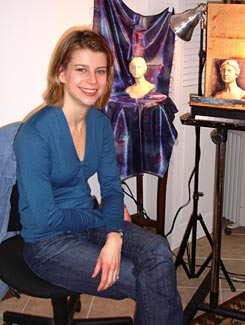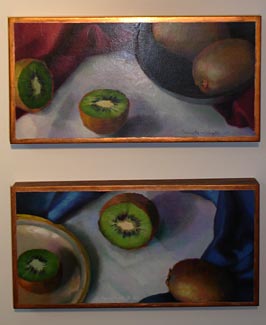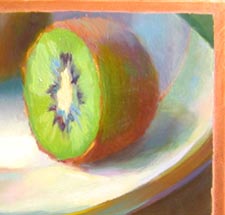Still Life on Copper: The Process of Discovery
 Artist Janet Cunniffe-Chieffo in her studio
Artist Janet Cunniffe-Chieffo in her studioPhotograph by Paul David
Artist Janet Cunniffe-Chieffo uses copper canvases to give her still life paintings of fruit, vegetables and flowers an almost three-dimensional look, breathing new life into these ordinary subjects.
"People are attached to the jewel-like images, the luminosity," says Cunniffe-Chieffo, of Denville, NJ. "Painting on copper allows me to capture a strong light and shadow effect. The work seems to glow."
With solo exhibitions, group shows and even teaching under her belt, this New Jersey resident is keeping busy. Cunniffe-Chieffo has been painting for 16 years, but it was in the last few that there has been an explosion of her work. Although she also produces figure work, portraits and landscapes on linen, there is something about the diminutive work she creates on copper that captures her imagination. She currently uses copper canvases as small as 3"x 3" and up to 12"x12", but is exploring the idea of using larger copper canvases in the future.
Though painting on copper isn't unique, it's also not as mainstream as one might think. For one thing, copper isn't the easiest canvas to work on.
"The surface can be irritating," she explains. "It's such a smooth surface that every brushstroke is apparent. However, that can also be advantageous."
Some pieces, she notes, work better with visual brushstrokes, adding to the depth and complexity of the painting. She obtains her clean copper sheets from a supplier in New York, sticking with 18 gauge in spite of the price spikes in recent years.
 Kiwi still life paintings on copper canvases
Kiwi still life paintings on copper canvasesPhotograph by Paul David
"The cost is something I'm willing to deal with because the advantages outweigh the disadvantages," adds Cunniffe-Chieffo. "Copper is also a durable material, unaffected by temperature and humidity."
Another advantage is that copper is still considered a unique medium. Galleries are not inundated with copper works like these---at least not yet. Additionally, collectors often want to pass a painting down to other generations or make a donation to a school.
"Copper is unique in that little restoration work is ever needed, unlike canvas or wood materials," she notes. "Plus, the look is as beautiful and luminous as when it was first created."
Cunniffe-Chieffo adds that the only downsides to using copper canvases are the cost and weight. A larger canvas requires a sturdier frame, adding to the weight and expense of a piece. But, this is a small price to pay when looking at these luminous still life works.
"I like the old master technique," she says of her process with copper sheet. "I lightly sand the copper with steel wool, and then paint a few layers of either a white or clear primer."
 Detail of Kiwi painting
Detail of Kiwi paintingPhotograph submitted by Janet Cunniffe-Chieffo
After her work is finished, she seals the painting with a semi gloss varnish. She then files the edges raw so the base copper is exposed and frames the piece.
Though she's comfortable with her current crop of still-life paintings, she plans to expand to landscapes and possibly even figure work on copper, to compliment her other body of work on canvas and linen. In the meantime, she continues to balance her artistic endeavors and spending time with her 16-month old daughter.
"She's a little artist in the making," says Cunniffe-Chieffo, who believes that becoming a mother has made her a more focused painter. "The process is always one of discovery."
Resources:
A short video of Janet demonstrating her basic preparation and techniques of painting on copper.
Also in this Issue:
- The Lee Robertson Method of Copper Arts
- Still Life on Copper: The Process of Discovery
- How a Historic Cupola Became Copper Art
- The Art of Early Copper Tools
- Cast Images: American Bronze Sculpture Highlights New York Works
